The best mic for acoustic guitar is able to isolate the sound of the guitar from surrounding sound sources. There are plenty of condenser and ribbon microphones on the modern market that are in a wide price range.
Since this musical instrument lacks volume knob to regulate the volume, no musician can dispense them. For this reason, the following list of the best microphones for acoustic guitar is helpful for choosing the appropriate product.
The mics below feature various diaphragms, settings, construction, polar patterns, and other specs. When choosing the right model, pay attention to the mic’s sensitivity and shock mount quality. Note that the analog units need additional hardware to be connected to a laptop and the others are ready-to-use with the comps.
Mic for Acoustic Guitar Reviews
AKG Pro Audio P420, Sliver Blue
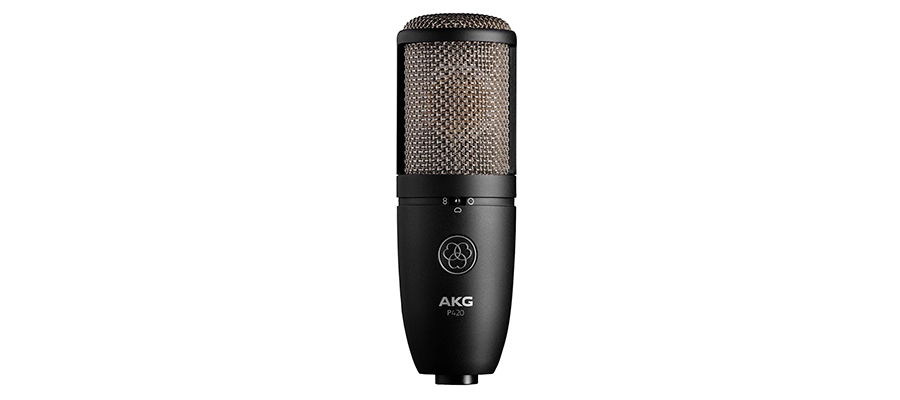
The AKG P420 review is about a dual-diaphragm project studio microphone with three selectable polar patterns. No specific software is needed to operate this mic; it’s enough to plug it into a mixer.
The device is well suited for the voice recording, as it has a smooth response, which reduces the likelihood of feedback. It allows speaking from it even at 2 ft away it being hooked up to a mixer/audio interface that has 48v phantom power. This model features a very neutral warm and clear sound. Due to its stable bottom end, it doesn’t color already deep sound.
When looking for the best mic for acoustic guitar, don’t miss this unit since it works perfectly if using it for a guitar or for other string instruments (violin, for example), as well as for vocals. However, it doesn’t fit symphonies where the extremely large distance between the mic and the instruments is required to pick up the ambiance. The mic has a standard clamp that’s why it works well with any mic stand and it’s attached easily to the boom arm.
As it is an analog device, it doesn’t have any specific sample rate or bit depth. To reveal these metrics, it is necessary to look at the audio interface or a sound card.
Pros
- The mic can be hanged upside down.
- The device comes with a durable 4-sided spider suspension shock mount.
- The unit comes in a sturdy metal suitcase.
Cons
- There are no cables in the package but just the mic and a shock mount.
- This analog device uses XLR connection and cannot be hooked up to a computer or a laptop for recording by default. It’s required buying a USB audio interface separately.
Neumann KM 184 Small Diaphragm Condenser Microphone

The Neumann KSM 184 is designed for small production and home recording studios. It’s able to provide high-quality sound in any situation. The sound matches between scenes on a project from interviews, large events, and B-roll footage.
It’s aimed mostly at acoustic instrument recording providing rich sound. It’s also well-balanced since it delivers smooth midrange and clear highs. This device features a good output and usual bass buildup when being moved close to the guitar. Besides, it comes with improved SPL handling and has extremely low noise.
In general, the mic fits all sorts of acoustic purposes. It’s possible to use it in a stereo pair, for drum overhead or hi-hat applications. In these situations, it ensures a lot of detail and articulation, as well as the brightness of the cymbals in their attack on the drums. So, the stereo image is flawless and, besides, the unit is compatible with classic “blackface” guitar amps. The unit is also great to be used in tandem with a large-diaphragm mic to provide the full range of sound coming from the source.
Pros
- It is produced with improved frequency response and signal-to-noise ratios.
- Ergonomic pencil-style design is implemented in a small and lightweight body that is very convenient for touring musicians.
- It is possible to dispense EQ, subject to recording in a decent room.
Cons
- It comes in a cardboard box that is typical only for low-cost mics.
- It has too small and flimsy clips that can break very soon with daily use.
Sennheiser E609 Silver Super Cardioid Instrument Microphone
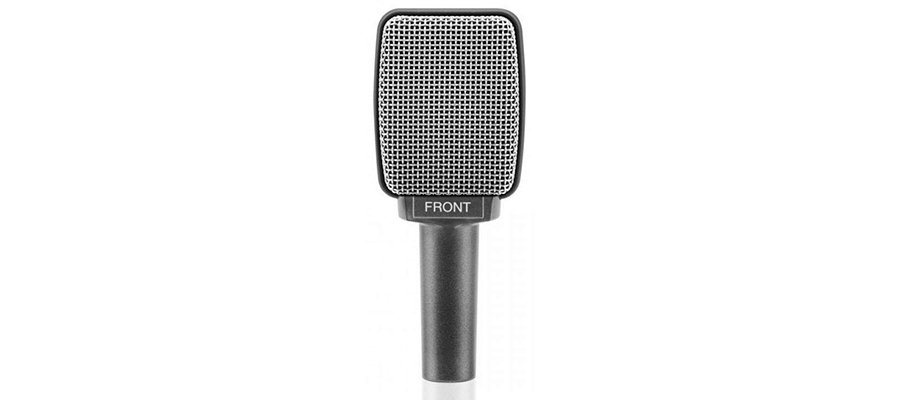
This Sennheiser guitar mic is a good all-round device for various instruments including even glockenspiel. It comes with a good cardioid pattern and the head’s design that is close up on the speaker. This feature allows preventing bleeding sound from the drums when recording in a less than ideal space. It also works excellent for vocal recording if pairing next to a large-diaphragm mic.
It provides a clear sound if hanging it in front of a guitar amp. The unit doesn’t compromise but even enhances the tone. It sounds naturally anywhere via the speaker and requires less EQ tweaking. It’s worth noting that this model is perfect for crunchy and high gain guitar where a ton of the high end isn’t crucial.
The unit also works well for such handheld percussion as shakers, tambourines, triangle, claves, etc. Note that this model isn’t a USB mic and it doesn’t come with a stand. It has an XLR connection and a mic clip to hook it up to a stand. To connect it via USB, it’s necessary to get a standard microphone XLR cable and a USB for a computer.
Pros
- As the device is designed as a cabinet mic, it features a warm sound and can be used for vocals.
- The mic holder is included.
Cons
- Though it’s good for rack toms, it doesn’t fit floor tom that requires more bass.
- It is a one-directional model, meaning that only silver side faces the speaker.
MXL Mics 770 Cardioid Condenser Microphone
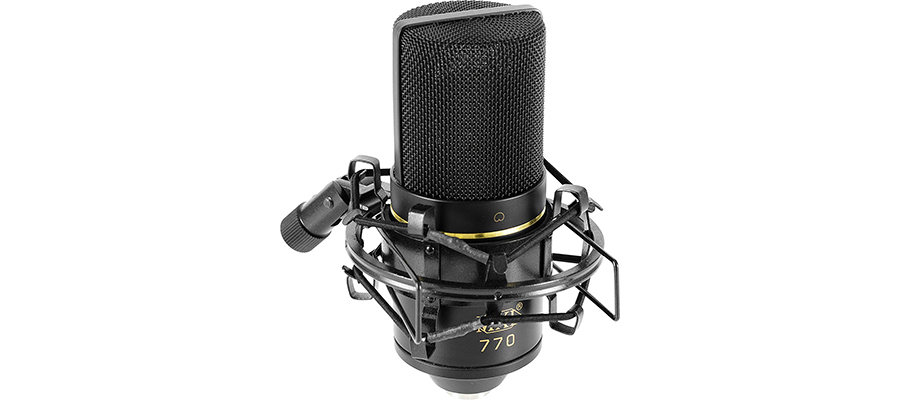
When thinking of the best mic for recording acoustic guitar, consider the MXL Mics 770 – a musician’s mic for stage purposes that picks up a lot of echo and PC noise. It’s sensitive and picks up the majority of noise in the room as well as outside the room unless it works in a quiet room or studio. Its -10dB pad switch is helpful to eliminate unwanted noises in the background.
It provides clear sound without any background hissing. The tone is rich and warm with a little equalization. The MXL Mics 770 features low-frequency roll-off for reducing proximity effects.
It fits various applications but, since it’s a standard XLR model, the phantom power supply units are required. By the way, XLR isn’t included that’s why it’s necessary to get a cable with female and male endings: to plug a female into the mic and a male – into the audio interface. Besides, it would be great to acquire a stand with an anti-vibration mount.
Pros
- The device comes in a hard case for both mic and shock mount.
Cons
- This model doesn’t have a port to plug studio monitor headphones.
- There is an on\off button, so it’s necessary to unplug it from the soundboard.
MXL 990 Condenser Microphone with Shockmount
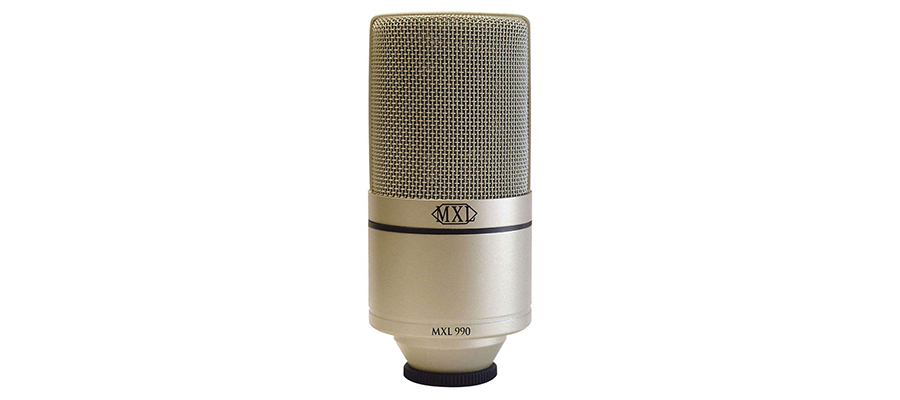
This microphone for acoustic guitar is small and it fits many acoustic instruments providing a totally flat response in the mid-range frequencies. It is very sensitive, as the majority of the condenser models, and it easily picks up any noise in the recording area and things outside the area, if lacking soundproofed space. It’s an XLR modification and it works as long as being connected to phantom power.
It’s a medium-diaphragm condenser, but it’s suitable for situations where the large-diaphragm units are used. It’s a very good sounding vocal microphone. The mic ensures a smooth and silky voice, but a good quality preamp is needed to that end.
Since it lacks a -10db pad, it’s not good for snares or kicking drums and it may not work well on stage with rock bands. If doing jazz at decent volumes the mic does its job. The MXL 990 is compatible with a home karaoke system, the correct mic input cords for the mixer are important.
Pros
- It provides rich tones.
- The mic has durable and good-looking aluminum construction with a metallic-champagne coating.
- The microphone’s frequency response changes when the mic is moved in the different directions around the capsule.
Cons
- There is no mute button.
- It needs a separate pop filter since there’s no foam inside the grill.
- This model comes without a microphone stand adapter; so, one should buy it, if hooking it up to a boom arm.
Samson C02PR Pencil Condenser Microphones
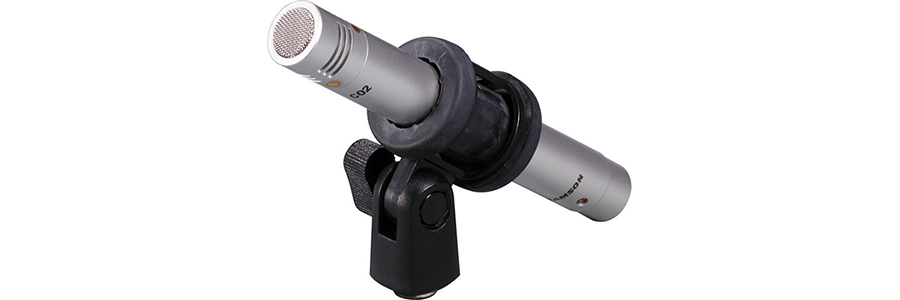
These microphones for acoustic guitar feature a wide frequency response that makes them excellent for use in any application. They shouldn’t be mounted directly to the guitar to avoid tons of noises and things picked up from the vibrations that would make for a bad recording. That’s why it’s better to use two microphone stands.
The Samson C02PR pick up clearly from a few inches from the mouth to a couple of feet away (overhead). No audio complications (clipping, for example) when recording something loud like drums.
There is no on/off feature and the product requires phantom power as every condenser model. Actually, it’s not a problem since many amps or mixers have a switch for that purpose. Note that each of the units is connected to separate channels, and each of them has its own individual phantom power settings.
Like other condenser units, these ones need a windscreen that one can buy separately. The mics are so sensitive that they pick up even breathing noise. However, when the windscreen is put on, it might muffle the mic. To get rid of this issue, just remove the inner layer of felt type material behind the foam.
Pros
- The devices are great for capturing a choir: they have a good range of about 6 feet.
- The shock mount that comes with the units fits any mic boom or mic stand.
- The mics come with their own mic clips that can’t be an isolation mount, but include an adaptor and hold the mic quite tightly.
Cons
- They don’t work well as drum overheads because they provide a thin sound. Besides, they lack presence and clarity, especially on cymbals.
Audio-Technica AT4040 Cardioid Condenser Microphone
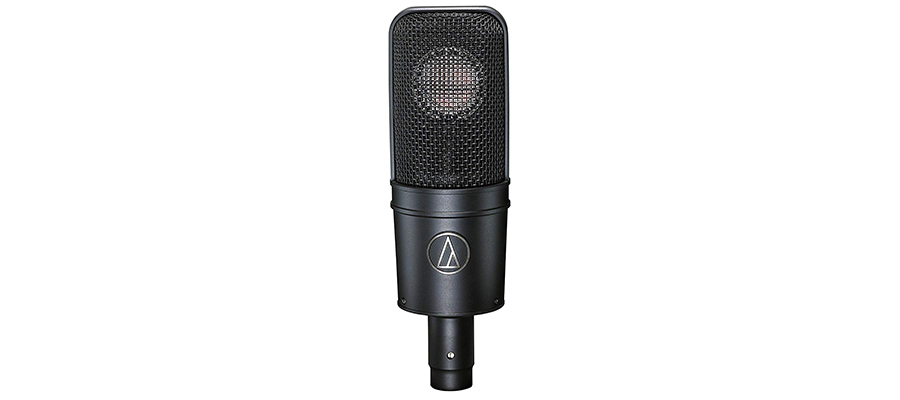
This acoustic guitar recording mic comes with a padded case for the mic itself, a shock mount to hold it on a mic stand, and a small velvet cover to keep dust off. The device is very sensitive and is able to capture even the sounds of the vehicles that drive by the house when recording or of the air conditioning unit when it’s on. However, there is no need for a totally silent room. Just make sure that ambient noise is reduced and whatever extra noise is left over in the recording, it’s not noticeable if other additional sounds are introduced in the song.
The mic has an articulate high-frequency response and a high pass filter switch that is great for overheads. Certainly, it might be a little harsh, but it’s possible to equalize it to get good results.
This product provides warm and clear sound regardless of the application that’s why it works flawlessly with all vocals, piano, guitar, and other instruments. The attenuation switch comes in handy when recording loud sounds and it also has a bass roll-off. The unit provides high-quality vocals without any coloring and the voice does not get muffled if the speaker/singer is very close to the mic.
Pros
- It’s good in a close-mic configuration.
- The included shock mount reduces unwanted noise while recording YouTube videos.
Cons
- The lower rubber band on the suspension requires many efforts to be positioned correctly.
Blue 1967 Yeti Pro USB Condenser Microphone
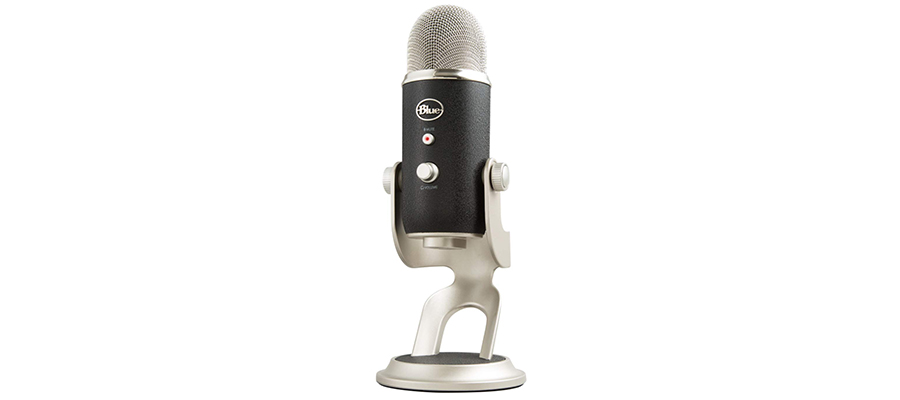
The Blue 1967 Yeti Pro provides the opportunity to make connections through both 5-pin XLR and USB cables. The unit comes with 4-feet USB cable and it’s needed to get an extender for longer connections. It has a short (as in about 6 inches) XLR dual-channel cable. So, when doing stereo mixes, it’s possible to control left and right separately. A stereo adapter to hook into the XLR connector is also in the package. The output of the adapter has two standard XLR male connectors that would go to the pre-amp for getting a stereo sound. It’s possible to dispense the pre-amp if there’s no need in stereo.
It’s a good mic, but it’s important to figure out how to position it. It’s best not to point it up or sideways directly or towards any other source of the noise. The sound quality of this microphone is great for recording. When speaking of the volume, it depends on the microphone preamp.
Pros
- The unit features a Gain knob to adjust it’s sensitivity directly on the mic itself.
- It has a headphone jack.
Cons
- The drivers have to be pre-installed from the website before using it, it’s not the instant plug-and-play device.
Buyer’s Guide
How to Use Mics for Acoustic Guitars?
The majority of the mics above are versatile but still, let’s deal with how to record guitars. First, connect the condenser mic to the equipment that supports phantom power. Then, position it correctly towards the instrument.
First, it’s crucial to angle a mic away from the soundhole of the guitar to avoid booming. So, place the mic opposite the sound whole but angle it at the strings pointing at 12th to 14th fret in order to provide the sound with the additional attack and presence.
The common practice is to locate the mic at a distance of 6 inches that is good to the mix where further adjustments will clarify matters. However, if the environment’s acoustics is under control, it’s allowed to increase the distance between the mic and the guitar (at least 1 foot away) to get a more neutral sound that is important when the acoustic guitar rolls in the song. This compromise strategy makes the sound perfectly balanced.
In the case of recording in various acoustic conditions, it would be great to get an omnidirectional mic that can be placed anywhere close to the guitar. If moving it a short distance away, it allows capturing a wider representation of the guitar’s sound.
Note that the rules of the mic’s placement can change since the sound quality tends to be rather subjective and very often, the metrics depend on the song and the guitar itself. Besides, it’s crucial to get a good guitar with fresh strings and take all the accessories (bracelets, necklaces, etc.) off to prevent clicking. One can use two mics that make each of them catch a different aspect of the guitar’s tone.
How to Choose a Mic for Acoustic Guitar?
There are several mic’s specs that should be considered when choosing either a high-end or an entry-level product.
- Sensitivity. More sensitive models produce higher output levels that need less amplification and add the unique sound texture in a specific application.
- Shock mount. The high-quality items are able to absorb vibrations and prevent undesired movement of the microphone.
- Diaphragm. The larger diaphragms ensure better sound quality.
- Frequency response. It should be flat and fast to provide accurate sound. The range from 80 Hz to 15 kHz is a good choice since those models are able to pick up the whole frequency spectrum – from lows to highs.
- Construction. Decent plastic mics are cheaper and can provide good sound, but metal units are more durable.
- Preamp. Some mics come with a built-in preamp increases the level of the output signal and the others need external devices.
- Connection. The XLR type of connection can be used in studios to enhance the guitar’s and the other instruments’ sound. When it’s necessary to connect the mic directly to the computer for editing the record and making other adjustments, USB cable comes in handy (plug right into a USB port). In the first case, the equipment that supports phantom power and the audio interface is required and in the last one, they’re not needed.
The polar pattern is also meaningful. It’s possible to get a mic with one of the three main polar patterns or to get them all. By the way, the all-in-one models with three polar patterns feature frequency response ranges for each of the patterns.
Now, deal with cardioid, figure-eight, and omnidirectional patterns. A cardioid mic has one operational side only that focuses only on one source of a sound, a figure-eight unit can be used as both front and rear, and the omnidirectional construction is designed to pick up sound all around. The latter allows placing the mic far away from the guitar.

Hi everyone! I’m Thomas Moody, also known as Guitarzan.
